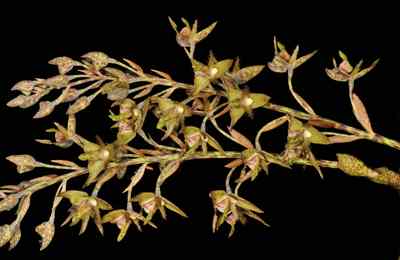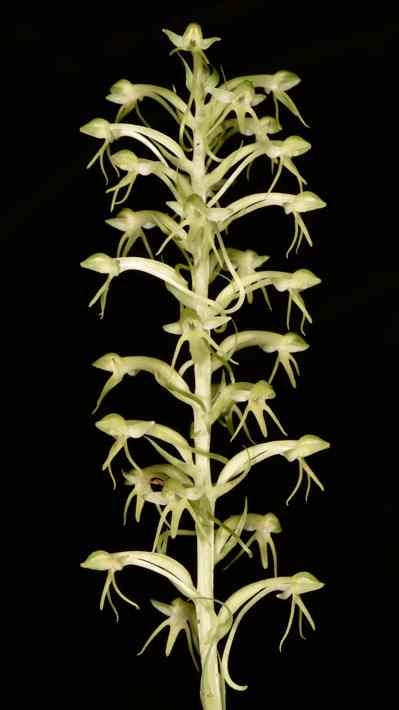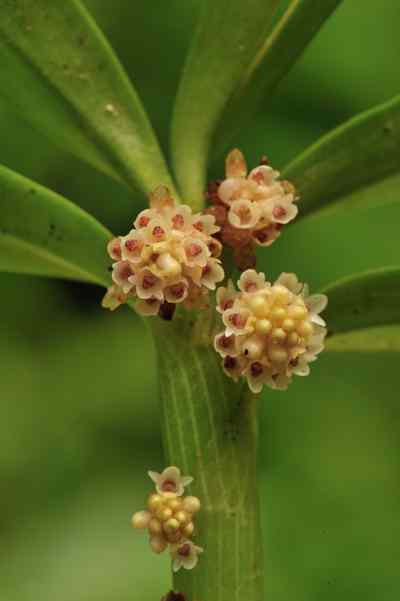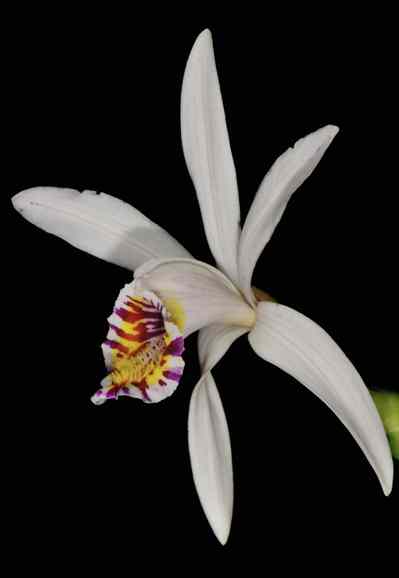The Plant
Epiphyte. A robust plant with stout erect stems, spreading decurved leaves and thick long roots. Stem clothed in the sheaths of dried leaves of previous season, 15 to 35 cm in height and 2 to 3 cm in width. Leaves 4 to 12, with equitant bases, keeled, bilobed, 20 to 35 cm in length and around 2 cm in width. Flowers in curved pendulous racemes arising from the base of the leaves, densely flowered.
The Flower
Peduncle short with a few small sheaths, raceme 12 to 30 cm long, ribbed. Flowers 1.5 to 2 cm across, attached in 1 to 1.5 cm long pedicels, sepals unequal, dorsal oblong, erect; lateral broadly ovate, much larger than the dorsal, blunt, lower margin slightly undulate, spreading. Petals narrower than the dorsal sepals, oblanceolate, blunt and spreading. Lip right angled, with its base narrow and channelled, margins bend upwards; the apex broadly retuse, side margins curved up and the disc with two short and narrow lamella like projections. Spur short, almost rectangular in shape and compressed. Floral bracts very small, lanceolate, attached on the upper side of the slightly curved and ribbed pedicels.
Sepals and petals white to pale pink with many irregular horizontal dark pink markings, more to their apexes. Lip of two shades, its base white to pale pink, disc dark pink, spur and pedicel pale pink, the latter with a darker shade to its apex. Floral bract brown.

The Pursuit
This species is nicknamed as “Foxtail Orchid” and is the State flower of the neighboring state of Arunachal Pradesh. It is a very important region in the Eastern Himalayan biodiversity hotspot blessed with more orchids than that of Sikkim-Himalayas.
This plant attracts the attention of one and all even without in flowers because of its appearance and leaf pattern. There are many varieties of this species, with much colour variations through out the tropical region of the Eastern Himalayas. King and Pantling in their monumental publication had illustrated and described a specimen of this species from the region of Sikkim-Himalayas, this helped me to narrow down and search this species from the tropical valleys of Sikkim-Himalayas only. As the plant is very robust in nature and can be found in many locations, the only matter left was to be there at the right time of its flowering. By the mid of April, I observed racemes arising in many plants. Made several visits to those spots and finally by the mid of May they all started blooming. When the flowers are in plenty, it is very difficult to choose a perfect one. In circumstances like that I always prefer those flowers, which are easy to be reached. Hence, I selected a plant from a relatively smaller tree and produced this wonderful photograph.
As this species produces a number of colour varieties I documented several specimens later on from various regions to study its colour patterns. They all have one thing in common, elegance!!!
Reference:
Rhynchostylis retusa Blume., Page no 213 – 214 of The Orchids of the Sikkim-Himalayas by Sir. George King and Robert Pantling (1898).








